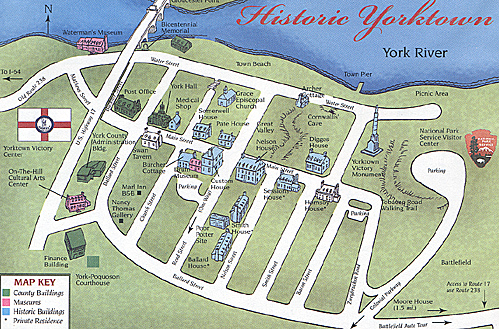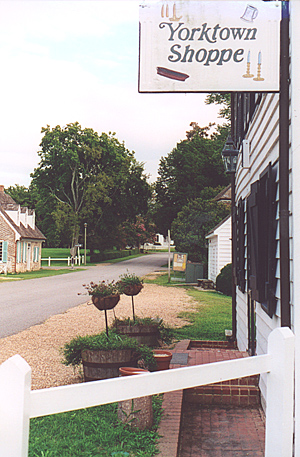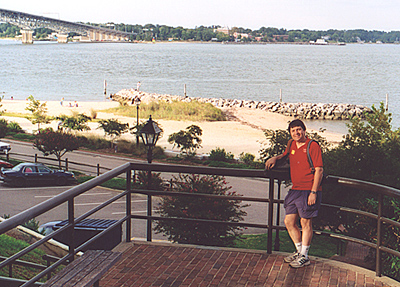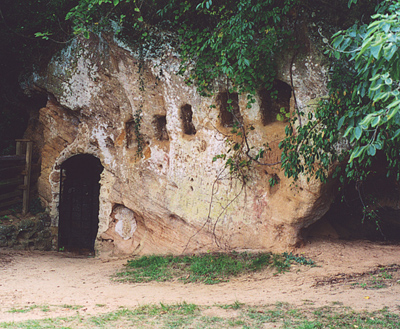 Yorktown began in 1691 by an act in the Virginia House of Burgess regarding the creation of ports through the colony. The state bought 50 acres from Benjamin Read and the town was surveyed into 85 half-acre lots, which my math says equals 42.5 acres. The pamphlet doesn't say what happened to the other 7.5, although maybe the roads, pubilc buildings, and port facilities took the amount, or it might have gone into a private holding to pay off the vote. You never know.
Yorktown began in 1691 by an act in the Virginia House of Burgess regarding the creation of ports through the colony. The state bought 50 acres from Benjamin Read and the town was surveyed into 85 half-acre lots, which my math says equals 42.5 acres. The pamphlet doesn't say what happened to the other 7.5, although maybe the roads, pubilc buildings, and port facilities took the amount, or it might have gone into a private holding to pay off the vote. You never know.
In 1697, the county courthouse was built, as was the Grace Church. By the early 1700s, the little port was in boom mode, with 200-250 buidings. Population reached its peak in the 1750s with about 1800 people, although the rush west for better tobacco soil began at this time.
 The siege of 1781 did much damage, and in a census of 1790, fewer than 70 buildings and only 661 residents remained. In 1814, a fire took most of the waterfront. Perhaps we can blame the British for that one.
The siege of 1781 did much damage, and in a census of 1790, fewer than 70 buildings and only 661 residents remained. In 1814, a fire took most of the waterfront. Perhaps we can blame the British for that one.
A look from the corner of Church Street and Main Street, with a view down Main Street towards the battlefield. The Pate House is on the left, at the corner of Main and Read Streets. Photo by Susan Lockwood.
Another shot of Main Street (slow: 106K)
Yet another shot of Main Street (slow: 81K)
A new courthouse was built in 1818, and during the Civil War, served as a powder magazine.
Yorktown During the American Civil War
In 1862, another siege of Yorktown began. Confederate Gen. Magruder dug in to resist Union Gen. McClellan's Peninsula invasion. Magruder had his men extend the long disused British earthworks, and resisted the Union until May.
On the night of May 3-4, 1862, Magruder opened up a thunderous bombardment of Union lines to mask his withdrawal back towards Richmond. The town served a Union garrison for the rest of the war.
In 1863, a fire broke out in the hospital bakery and quickly spread until it reached the courthouse and the Swan Tavern--both serving as powder magazines. The resulting explosion leveled the northwestern side of town.
The Present
 Most everything else passed it by, although the Rte 17 bridge is near. As we walked around this sleepy little village in the early evening, we took in some of the colonial building sights.
Most everything else passed it by, although the Rte 17 bridge is near. As we walked around this sleepy little village in the early evening, we took in some of the colonial building sights.
The bridge in the upper left, while MagWeb.com CEO Russ Lockwood poses on the stairway overlooking the beach. Photo by Susan Lockwood.
The Customs House (slow: 129K)
The Sessions House (slow: 119K)
 Eventually, we headed downhill to the waterfront and walked along the York River on Water Street. Here, we found Cornwallis' Cave, a place used by the General to escape the 1781 bombardment. It's been fitted with a grill to keep out tourists and other vagrants. Whether or not he really stayed in a cave is similar to questioning whether George Washington slept in a particular home in NJ. Even if he didn't, it still makes a good story.
Eventually, we headed downhill to the waterfront and walked along the York River on Water Street. Here, we found Cornwallis' Cave, a place used by the General to escape the 1781 bombardment. It's been fitted with a grill to keep out tourists and other vagrants. Whether or not he really stayed in a cave is similar to questioning whether George Washington slept in a particular home in NJ. Even if he didn't, it still makes a good story.
And with that, we headed back to the car and Fort Monroe, a fitting end to a lovely Sunday afternoon jaunt.
Back to List of Historic Sites
Back to Travel Master List
Back to MagWeb Master List of Magazines
© Copyright 2003 by Coalition Web, Inc.
This article appears in MagWeb (Magazine Web) on the Internet World Wide Web.
Other articles covering military history and related topics are available at http://www.magweb.com